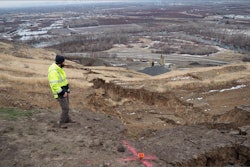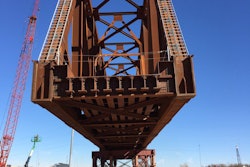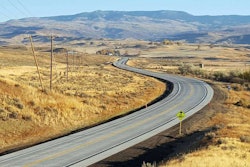
A new report finds there’s the equivalent of one “structurally deficient”-rated bridge, on average, for every 27 miles of the nation’s major highway network, according to the American Road & Transportation Builders Association (ARTBA).
Those 1,800 structurally deficient interstate bridges are crossed 60 million times daily, the association says.
But the problem is even bigger, according to the analysis of the U.S. Department of Transportation’s newly released 2017 National Bridge Inventory database.
In total, 54,259 of the nation’s bridges are rated structurally deficient, says Alison Premo Black, chief economist for ARTBA, which advocates strong investment in U.S. infrastructure. Black conducted the analysis.
If placed end-to-end, the deficient bridges would stretch 1,216 miles, or nearly the distance between Miami and New York City, ARTBA says.
Cars, trucks and school buses cross these 54,259 compromised structures 175 million times every day, the data show.
Excavator breaks though bridge deck
In Missouri, Allen McClelland, who owns a marketing company that represents manufacturers’ Midwest territories, has seen the problem up close.
McClelland says he witnessed an excavator break through a bridge deck in Missouri last August. He spoke up during an educational session he was attending on infrastructure funding at the recent summit of Associated Equipment Distributors in Las Vegas, telling other attendees of the incident.
The bridge in the Camdenton area near Lake of the Ozarks had been closed to traffic just before work began to replace the deck, according to McClelland. As a representative selling hydraulic breakers for Atlas Copco, he was there to install the hammer.
“They pulled the excavator out on the deck, and it started crumbling, and instead of using a hydraulic breaker, the guy stuck the bucket teeth through, grabbed the rebar mat and pulled it out. There was nothing there.”
McClelland provided further details in an interview: “We had a big hammer there to take out the footings, and he literally grabbed the footings once they got the bridge down, and they just pulled out,” McClelland tells Equipment World.
“They were there to tear the bridge out. But people were literally driving on that bridge that morning, and that’s how rotten it was,” he says, stressing that the bridge could have collapsed at any time.
“There was nothing supporting the bridge from a structural standpoint underneath it.”
Shortly after that, he was at another bridge on Hwy.100 outside of Herman, Missouri, and saw a rotten deck in nearly as bad of shape, McClelland said.
According to Artba’s analysis, released Jan. 29, Missouri ranks fourth in the nation in total number of deficient bridges. Iowa had the most.
Moving the nation’s economy
The nearly 48,000-mile U.S. interstate highway system carries 75 percent of the nation’s heavy truck traffic, according to ARTBA.
Despite the need, the pace of improving the nation’s inventory of structurally deficient bridges slowed this past year, according to the analysis.
It’s down only two-tenths of a percent from the number reported in the government’s 2016 data. At current pace of repair or replacement, it would take 37 years to remedy all of them, ARTBA says.
Noting President Trump is expected to address the nation’s infrastructure challenges in his Jan. 30 “State of the Union” address, Black says:
“An infrastructure package aimed at modernizing the interstate system would have both short- and long-term positive effects on the U.S. economy.”
Traffic bottlenecks, she says, costs the trucking industry alone more than $60 billion per year in lost productivity and fuel, which “increases the cost of everything we make, buy or export.”
To help ensure public safety, bridge decks and support structures are to be regularly inspected for deterioration and remedial action.
They are rated on a scale of zero to nine—with nine meaning the bridge is in “excellent” condition. A bridge is classified as structurally deficient and needing repair if a rating on a key structural element is four or below.
While these bridges may not be imminently unsafe, they are in need of attention, Black says.
Deficient bridges, by the numbers:
- Iowa (5,067), Pennsylvania (4,173), Oklahoma (3,234), Missouri (3,086), Illinois (2,303), Nebraska (2,258), Kansas (2,115), Mississippi (2,008), North Carolina (1,854) and New York (1,834) have the most structurally deficient bridges.
- At least 15 percent of the bridges in six states—Rhode Island (23 percent), Iowa (21 percent), West Virginia (19 percent), South Dakota (19 percent), Pennsylvania (18 percent) and Nebraska (15 percent)—fall in the structurally deficient category.
- The District of Columbia (8), Nevada (31), Delaware (39), Hawaii (66) and Utah (87) have the fewest.
Information including rankings and locations of the 250 most heavily travelled structurally deficient bridges in the nation, and also the top 25 most heavily traveled in each state, is available at www.artbabridgereport.org.
Though states have taken the lead on implementing gas taxes, all eyes are on Trump for his long-awaited infrastructure plan to be announced Jan. 30, with many calling for a federal gas tax.
Based in Washington, D.C., ARTBA calls itself the “consensus voice” of the U.S. transportation design and construction industry before Congress, the White House, federal agencies, news media and the general public.










